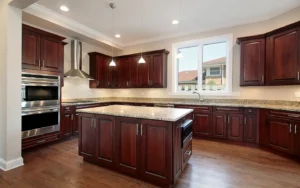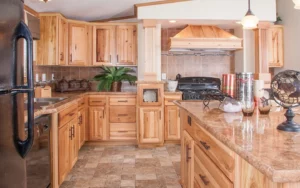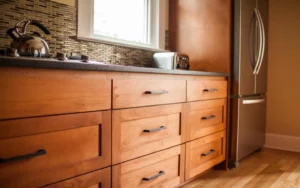Selecting the ideal wood for cabinets is not just about aesthetics; it’s a blend of functionality, longevity, and design. Each type of wood, with its distinct characteristics, speaks to different styles and functional needs. Dive deep into the world of wood types to discover the perfect match for your cabinetry aspirations.
Read More About : kitchen cabinet types
Cherry Wood: A Touch of Luxe in Every Grain
Cherrywood is often associated with luxury, and rightly so. Sourced primarily from the eastern US, this medium-to-hard wood is renowned for its deepening reddish-brown hues, a more pronounced trait with age. Its grain is typically straight, fine, and closed, offering a smooth texture perfect for a polished finish.
For those keen on intricate designs, cherry’s tight grain supports detailed carving and styling. It effortlessly fits into various design schemes, from traditional to modern minimalist. But, like all luxury items, cherry wood demands care. While it’s naturally resistant to rot and decay, it’s sensitive to light, meaning prolonged direct exposure can lead to a subtle darkening of its hue. Price-wise, cherry sits on the higher end, but its durability and timeless elegance make it a worthy investment for many homeowners.

Oak: Nature’s Masterpiece in Durability and Aesthetics
Oak, one of the most widely used hardwoods for cabinets, has etched its mark in the cabinetry world through its formidable strength and unique grain patterns. Predominantly sourced from North America, oak comes in two shades: pinkish-red and lighter white oak. Its grain is distinct, with patterns that can be both subtle and bold.

Functionally, oak is resistant to wear, making it perfect for high-traffic kitchens and busy households. Its inherent toughness guards against dents and scratches, standing tall against daily wear and tear. However, it’s very prominent grain may not be everyone’s cup of tea, especially if they prefer a smoother, more uniform appearance. Nevertheless, its versatility in adapting to contemporary and classic styles and its relative affordability make it a favorite.
Hard Maple: The Canvas of Modern Cabinetry
Hard maple often tops the list when considering a wood type that exudes modern sophistication. With its origins in North America, this light-colored wood, interspersed with slight reddish-brown tints, offers a consistent grain pattern ideal for a clean, sleek finish.
Its popularity isn’t just skin-deep. The wood is commendably hard, proving a reliable choice for kitchens that experience daily culinary adventures. Its smooth surface is a delight for designers aiming for painted or stained cabinets, and while hard maple generally showcases a uniform appearance, occasional mineral streaks add character, providing a touch of rustic charm.
Pine: Rustic Charm Meets Affordability
Pine, a softwood, stands in contrast to its hardwood counterparts but shines uniquely. It’s the go-to choice for homeowners with a country or rustic aesthetic. Sourced primarily from Northern Europe and North America, pine is lighter in color, with shades ranging from yellow to white. Its standout features? The knots. These patterns lend pine cabinets an unmistakable charm, perfect for cozy settings.
While its soft nature makes it easier to work with, especially for intricate designs, it is also prone to dents and scratches. However, this vulnerability can also be its strength, as the naturally occurring “distressed” look adds character over time. And for those on a tighter budget, pine emerges as a cost-effective yet charismatic choice.
Hickory: The Bold and Beautiful
Hickory, often described as the most robust American wood, is a force to be reckoned with. Its rugged strength ensures it can withstand the test of time, making it ideal for busy households. But what truly sets hickory apart is its dramatic color variations. Ranging from light beige to dark brown within the same board, it promises visually stunning and unique cabinets.

However, this very feature can pose a design challenge. Striking the right balance in color variations requires careful planning. It’s best suited for larger kitchens where dramatic contrasts can be displayed without overwhelming the space.
Walnut: Timeless Elegance Meets Modern Day
Walnut is undoubtedly a gem in cabinetry woods, known for its warm dark tones, ideal for those who gravitate towards a rich, sophisticated ambiance in their living spaces. The American Black Walnut stands out with its unique, varied grain that can range from straight to wavy. The color palette of walnut wood typically includes deep browns with hints of purples and gold, ensuring that each cabinet crafted from this wood is a piece of art.
Walnut is tough and durable, resistant to natural decay and everyday kitchen mishaps. It can be polished to a fine luster, making it a favorite for traditional and ultramodern interiors. One should be aware. However, that walnut can come with a heftier price tag, given its top-tier qualities and the increasing demand in the luxury housing market.
Birch: The Understated Workhorse
Birch, a hardwood native to North America, often flies under the radar compared to its more illustrious peers, but its merits in the cabinet world are plenty. With a tight grain pattern and a color spectrum that ranges from cream to a light reddish-brown, birch is particularly appealing for those aiming for a minimalist or Scandinavian aesthetic.
Its physical properties are commendable as well. Birch stands strong against moisture, ensuring longevity even in more humid climates. It’s also relatively easy to stain, allowing for color customization. While it may lack the natural luxury of wood like cherry or walnut, its affordability, and adaptability make it a favorite for budget-conscious renovations without compromising quality.
Explore More: custom kitchen cabinet
Alder: Flexibility in Form and Function
Alder, primarily found in the Pacific Northwest, makes waves in interior design. Its light tan to reddish-brown hues, combined with a fairly straight grain, offers a neutral canvas that’s both versatile and beautiful. The wood is relatively soft for a hardwood, making it particularly receptive to staining. This means that alder cabinets can mimic the look of many other more expensive kinds of wood, granting homeowners flexibility in design without stretching the budget.

One of Alder’s standout features is its natural ‘blemishes’ – small pin knots and open knots that give it a rustic charm. Alder provides an organic, earthy feel for those yearning for a touch of the outdoors. However, its softer nature means it might be more susceptible to dents and scratches, so it’s essential to consider the household’s activity level before committing.
Mahogany: A Touch of Exotic Luxury
With its origins in tropical rainforests, Mahogany is often associated with opulence and luxury. Known for its reddish-brown hue that deepens over time, it exudes warmth and richness like no other. Its fine, even grain allows for a polished finish, making it a timeless choice for elegant interiors.
Besides its undeniable beauty, Mahogany’s strength and stability are worth noting. The wood resists warping, shrinking, and swelling, ensuring cabinets retain their shape and beauty for decades. It’s also naturally resistant to decay and pests. However, Mahogany can be more expensive given its exotic origins and declining supply due to over-harvesting. Investing in Mahogany elevates a space’s aesthetic quotient and speaks volumes about one’s commitment to lasting quality.
In conclusion, the realm of cabinet woods is vast and varied. From the luxurious cherry to the rugged hickory, there’s a perfect wood waiting to bring your cabinetry vision to life. Choose wisely and let the beauty of nature elevate your interiors.
KEYWORDS:
